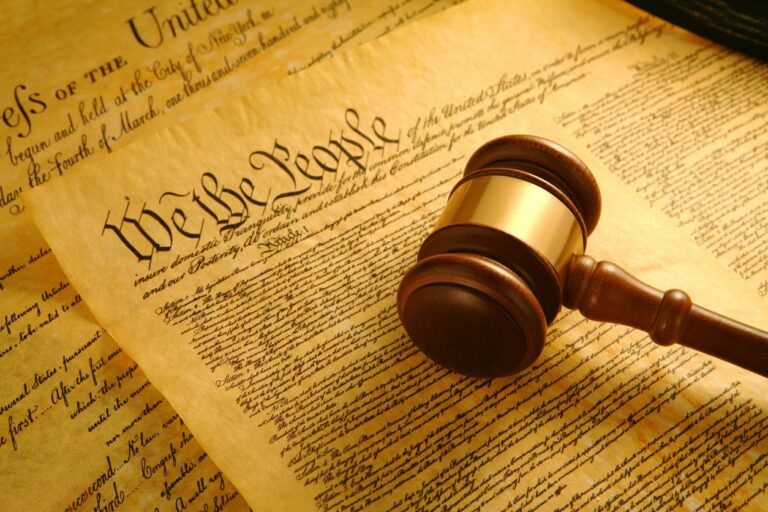newYou can listen to the Fox News article!
On September 17th, exactly 235 years after the Constitution was signed, we celebrate Constitution Day. At least, some of us do. Constitution Day's precursor was called “I Am an American Day” and once drew enthusiastic crowds who celebrated with speeches and songs. Today, the holiday gets little attention. Others use it as an excuse to criticize our governing document, the world's longest-standing government charter.
Whether it's because the document “restricts democracy” or thwarts popular attempts to inject racial politics into law, hatred of the Constitution has become so mainstream that The New York Times recently suggested the document is “dangerous,” “bankrupt,” and “should never be brought back.” Who would have thought that universal, timeless principles like equality under the law, due process, civil rights, and limited, enumerated powers would become so controversial?
Contrary to what critics say, the greatest injustices in our history have occurred when government has strayed from the original meaning of the Constitution. Consider Plessy v. Ferguson, Korematsu v. United States, and Buck v. Bell. Each is a stain on our legal history, and each occurred because the Supreme Court strayed from the letter of the Constitution.
Rare copy of U.S. Constitution found in old filing cabinet goes up for auction
The Plessy case needs no summary. It is one of the most well-known and hated cases in history. Homer Plessy's case began after he was arrested for refusing to move from a whites-only car. He challenged Louisiana's segregated carriage law, which mandated racially segregated carriages, arguing that it violated the Equal Protection Clause of the Fourteenth Amendment to the Constitution.
The United States Constitution remains strong after 235 years. It is only when judges stray from the original intent of the Constitution that problems arise. (spxChrome)
However, the Supreme Court, in an 8-1 opinion, upheld Plessy's conviction and endorsed the separate but equal theory: “Laws permitting, or even requiring, segregation do not necessarily imply that one race is inferior to the other,” Justice Henry Brown wrote. Only one justice dissented.
It took 58 years and the tireless efforts of civil rights heroes like Supreme Court Justice Thurgood Marshall to overturn Plessy in Brown v. Board of Education, a unanimous Court decision that recognized the Constitution's long-standing requirement that “separate is inherently unequal” and the need for desegregation.
Korematsu v. United States represents another glaring injustice. After the attack on Pearl Harbor, Democratic President Franklin D. Roosevelt issued an executive order to intern more than 120,000 people of Japanese descent, two-thirds of whom were U.S. citizens. After Fred Korematsu was arrested and convicted for refusing to comply with the internment order, he challenged his conviction in court. However, the Supreme Court upheld Roosevelt's order because it was “military necessary.”
Three justices dissented. In perhaps the most famous dissent, Justice Robert Jackson wrote that Korematsu was convicted of “conduct not commonly thought of as a crime,” “simply because he was in a state of citizenship, near where he was born, and in a place where he has spent his entire life.”
In a separate dissent, Justice Frank Murphy called the deportation orders a “legalization of racial discrimination.” The Supreme Court did not officially correct the error until 2018, when Chief Justice Roberts wrote that “Korematsu committed serious error when it was decided.”
Less well known but equally egregious is Buck v. Bell. In this case, Carrie Buck was committed to a psychiatric hospital and forcibly sterilized at the age of 18. Although she had the mental age of a 9, one of her doctors claimed she was a menace to society. In court, Buck's lawyers argued that the law deprived her of due process and equal protection.
Click here to read more FOX News Opinion
Buck lost in every court that heard her case, including the Supreme Court. Justice Oliver Wendell Holmes Jr., who wrote the majority opinion, said that Buck, who is “mentally disabled,” is the daughter of a “mentally disabled” woman and the mother of a “mentally disabled” child.
He dismissed her constitutional claims as against the “public welfare.” According to Holmes, “three generations of fools are enough.” Unlike the two earlier cases, Buck has never been officially overturned, although subsequent litigation has weakened its effectiveness.
It took 58 years and the tireless efforts of civil rights heroes like Supreme Court Justice Thurgood Marshall to overturn Plessy in Brown v. Board of Education, a unanimous Court decision that recognized the Constitution's long-standing requirement that “separate is inherently unequal” and the need for desegregation.
The critics are right: the Constitution is anti-majoritarian, limiting democracy even when majorities seek to sterilize those they deem weak. And certainly, the Constitution frowns on race-conscious government action, even those deemed harmless or essential to national security. But in retrospect, our country might have benefited from a more fervent commitment to individual rights and skepticism of race-conscious legislation.
Click here to get the FOX News app
Constitution Day is a good time to recognize the virtues of the Constitution. Those who complain that the Constitution “created Trump” should consider all the ways in which it limited his power while in office. Those who complain about the Constitution's protections for free speech should acknowledge America's past disastrous attempts to restrict objectionable expression and the ways in which the Constitution was written into it.
The Constitution's popularity may wax and wane, but its meaning and importance remain constant. When the government tries to punish people born with the “wrong” skin color, or tries to strip people of fair process and basic civil rights, the Constitution is there whether we celebrate it or not.


